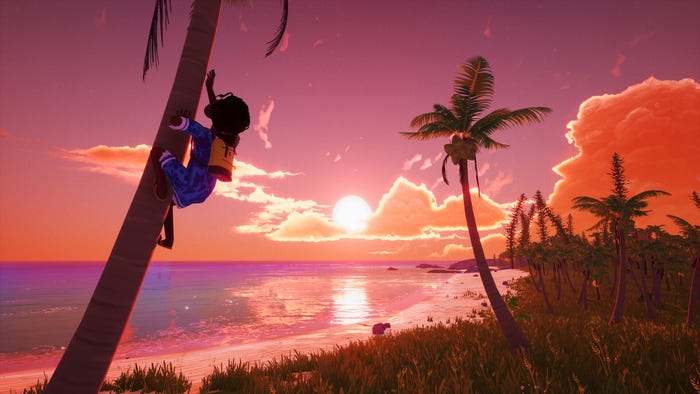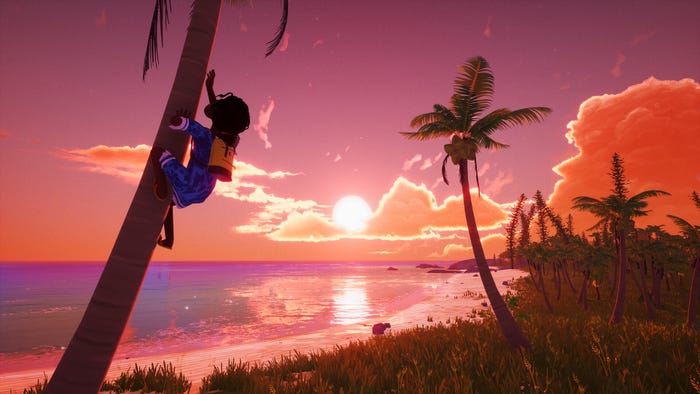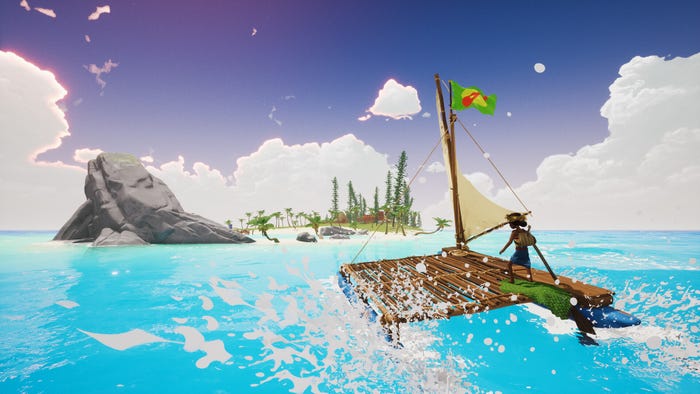
The IGF (Independent Games Festival) aims to encourage innovation in game development and to recognize independent game developers advancing the medium. Every year, Game Developer sits down with the finalists for the IGF ahead of GDC to explore the themes, design decisions, and tools behind each entry. Game Developer and GDC are sibling organizations under Informa Tech.
Tchia sets players free in a striking tropical world inspired by the creator’s home of New Caledonia, allowing them to become any animal or object they like as they explore.
Game Developer caught up with Phil Crifo, the game’s director, to talk about what first interested them about telling a story set in their home of New Caledonia, how local myths and legends helped form a part of the game’s animal and object-controlling mechanics, and creating a soundscape that captured the feel of their home through its music.
Who are you, and what was your role in developing Tchia?
I’m Phil Crifo, co-founder and creative director at Awaceb. I was the game director on Tchia.
What’s your background in making games?
I come from a cinema and 3D animation background, making many short films and video projects. At some point I realized I was deeply inspired by video games but was lacking the technical knowledge to actually make them, which was preventing me from even considering the possibility. I decided to take a leap and I teamed up with my childhood friend Thierry Boura, who had a programming background, and we started work on our first title, Fossil Echo.

Images via Kepler Interactive
How did you come up with the concept for Tchia?
As we sat down to think about our second project, I thought about what made us stand out from other teams out there, and from the indie games landscape altogether. It quickly became obvious that our New Caledonian background was unique and rarely portrayed in games—rarely portrayed and in any media for that matter, and was something we could channel to tell a unique story.
What development tools were used to build your game?
We used Unreal Engine 4 alongside some middleware, including FMod for audio.
What appealed to you about creating an island adventure set in your homeland?
The fact that it felt like only we could tell that story—that it was really personal and specific but, at the same time, had that universally appealing aesthetic and vibe. It felt like a really rich source of inspiration, and also a safe and reassuring one, in a way. Because we are so familiar with the subject matter, it gave us a lot of confidence to jump headfirst into an ambitious project.
How did you introduce the whole team to New Caledonia? How did you show the team the culture, sound, look, and feel of your homeland?
At first, it was a lot of experience sharing—talking about life there, our childhoods there as well as a lot of photo references and documentation. We didn’t set out to make a perfectly faithful rendition, so it was more about conveying the vibe and energy of the place as best as possible, which I think we largely achieved. Ultimately, we took the whole team on a trip to New Caledonia when budget allowed, and that also informed some details and specific elements in the game, even though it was later in the development cycle.

Images via Kepler Interactive
How did you design the creature-controlling gameplay of Tchia? What interested you in having the player be able to take on different forms to explore?
We really wanted Tchia to have a unique ability to make exploring the world fun and engaging. We went through many iterations including telekinesis, or more standard possession where Tchia would stay in place. Through iteration, it evolved into the Soul-Jumping mechanic, which allows for smooth, flowing locomotion. It also made sense thematically, as a lot of New Caledonian myths and legends involve shapeshifting humans and animals.
What thoughts went into the various forms players could take on? How did you pick which animals and things players could take over, and how did you give each a unique use in the game?
We didn’t! We designed it as a sandbox mechanic rather than a specific puzzle-oriented mechanic. The idea was to let players Soul-Jump into anything (or at least, as many things as possible) and make their own fun. A lot of the objects and animals you can control don’t serve a specific purpose, but I think that’s part of the fun. Just knowing you have the option to do so and tinkering with the system without being goal-oriented all the time was part of the “toybox” design approach we had for the game.
What thoughts went into creating the sound style for Tchia? How did the musical styles and sound of New Caledonia shape the songs in the game?
Music is a very important part of New Caledonian culture, and it was obvious from the start that it should play a major role in the game. That said, some local sonorities and rhythms can be complicated to grasp and enjoy for people who aren’t familiar, so we really wanted to strike a balance between an orchestral score that has those familiar patterns with local sonorities and instruments that bring a unique texture and energy to the soundtrack.
Can you tell us a bit about the local instruments and sounds of New Caledonia? What are the sounds they brought to the game that made it sound special and unique?
Many local instruments are featured in the game, including Bwanjep, which are percussive instruments made of dried tree bark that you hit together. Sonaï are large empty seeds attached to the ankles that create a unique rattling sound. All those instruments have a connection to nature. Most of the time they are made of very simple elements and played in fairly simple ways, making them very “raw” and down-to-earth in a way.

Images via Kepler Interactive
What feelings did you want to stir in the player with the game’s music?
I think that mix of sonorities creates a soundtrack that draws you in towards the earth rather than lifting you up towards the skies (as many traditional orchestral compositions tend to feel). The idea was for players to feel immersed in an unfamiliar, mysterious, but ultimately welcoming and inviting place.
What drew you to add a fully-playable ukulele in the game? Why was that an important addition to you?
The ukulele came along from the “toybox” game design approach and a need to put music at the heart of the experience to match its importance in New Caledonian culture. It was an incredibly important addition and was one of the first mechanics we prototyped.
What challenges did you face in making a realistic playable instrument? What did you do to help players learn how to play it?
Turns out that trying to make something that is already really hard in real life playable on a game controller is a challenge! We had to cut corners in what was possible to do, but I think we went above and beyond to make it as fleshed out as possible so that people who wanted to use it as a proper virtual instrument would be able to play basically any song on it (again with the “toybox” approach). Similarly to the Soul-Jumping, we “over-designed” it in the sense that we didn’t just make it to serve a gameplay purpose, but to be a standalone tool for people to have fun with. That said, the game does use it to trigger open-world effects as well as narrative musical segments, both of which use control schemes that make it way more user friendly than the freeform virtual instrument.
What was it like to weave a world out of a home you know so well? Did you take anything special away from creating an experience set in your homeland and interwoven with your local culture?
If anything, it deepened our appreciation for the place, its people, its cultures, and biodiversity. We had to take a deep dive into something we thought we had a good grasp on, but realized there was still so much to learn, which was humbling. Like I mentioned, I think it was incredibly valuable to have that backbone to refer ourselves to when we had questions about design, narrative, art, music. It gave us something to rely on.
Ultimately, the response from the folks back home is the final validation that makes us feel really good about what we made. I think it honors the place while making it accessible and universal, which was the goal from the start.






